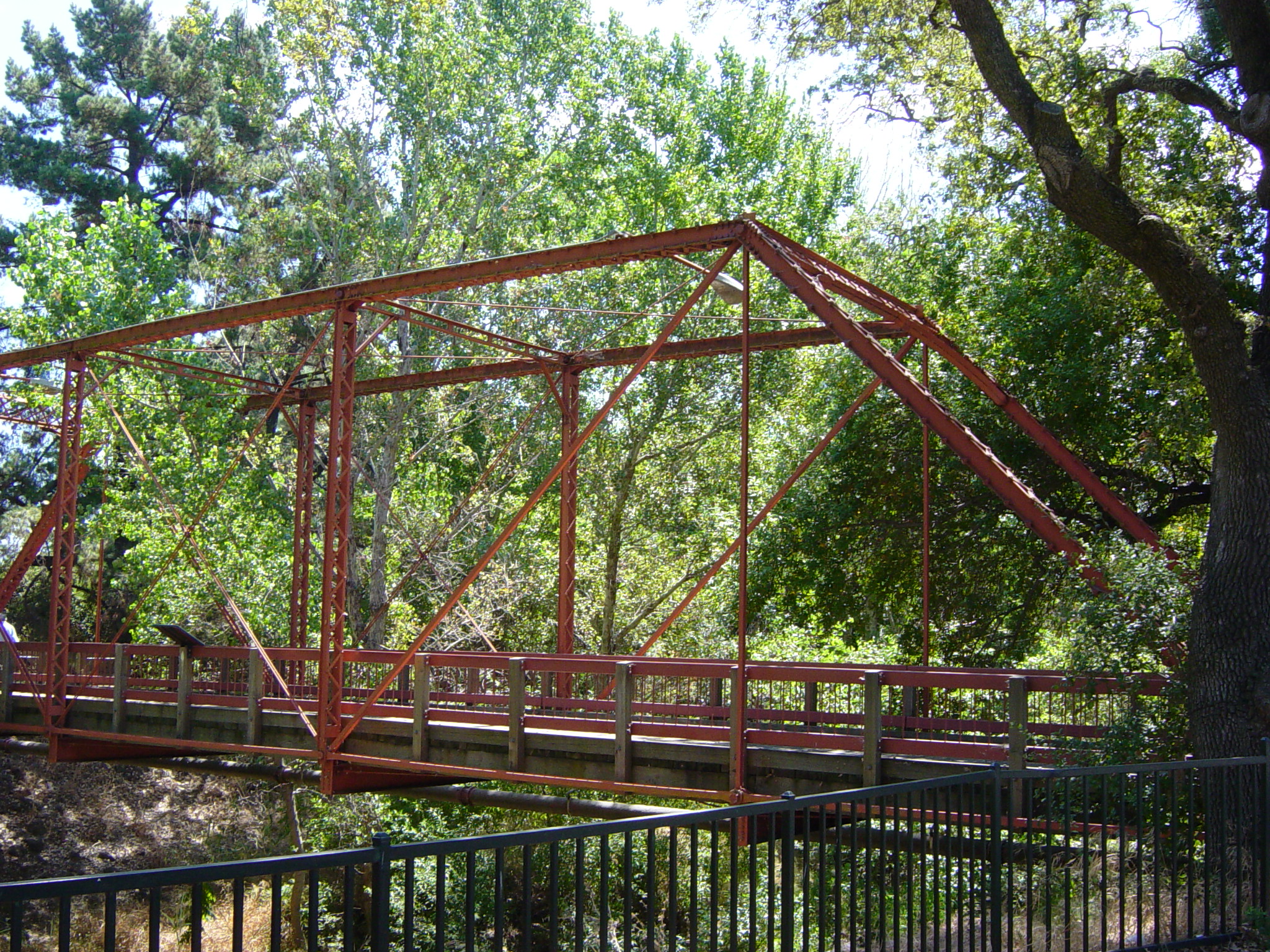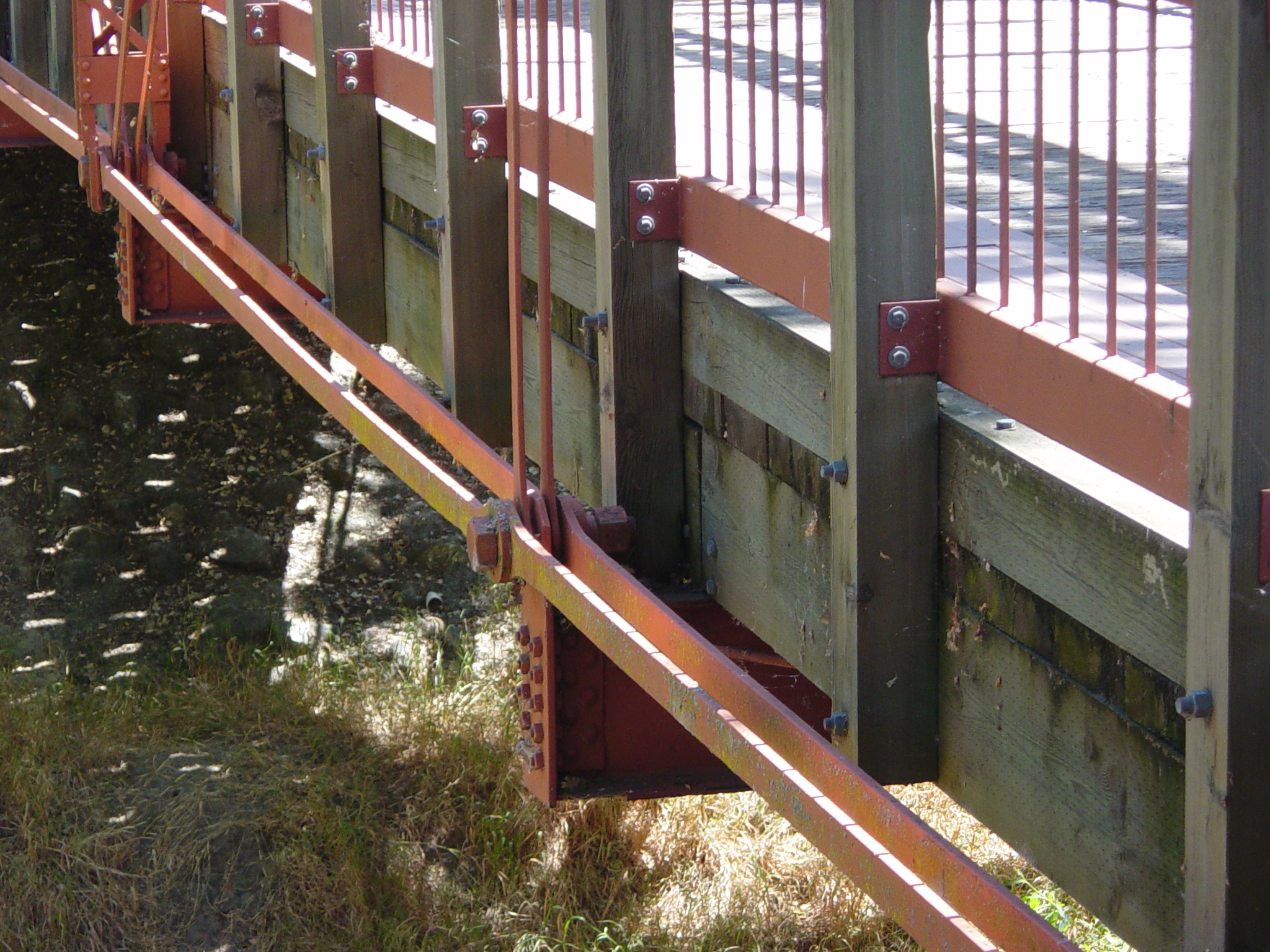Eyebar on:
[Wikipedia]
[Google]
[Amazon]
 In
In
 A closed eyebar will typically have a
A closed eyebar will typically have a
 The bars may be fabricated with pin holes that are slightly undersized. If so, these are then
The bars may be fabricated with pin holes that are slightly undersized. If so, these are then 
https://archive.org/stream/forgingofeyebars01loss#page/n1/mode/2up . thin iron metal on top of one another and forging it together in a furnace. Once together the piece was heated and hammered into a U shape over a die. To create the eye the heated bent iron was hammered into itself closing the gap and creating the eye shape. This method created a quick and efficient way to create the bar, however would not structurally stay together after a certain point due to the piling method being ill heated or being defective.
http://www.wvculture.org/history/wvhs/wvhs1504.html .
Casting In Iron
- 1940-1949 - British Instructional Film Structural system
structural engineering
Structural engineering is a sub-discipline of civil engineering in which structural engineers are trained to design the 'bones and muscles' that create the form and shape of man-made structures. Structural engineers also must understand and cal ...
and construction, an eyebar is a straight bar, usually of metal
A metal (from Greek μέταλλον ''métallon'', "mine, quarry, metal") is a material that, when freshly prepared, polished, or fractured, shows a lustrous appearance, and conducts electricity and heat relatively well. Metals are typicall ...
, with a hole ("eye") at each end for fixing to other components. Eyebars are used in structures such as bridge
A bridge is a structure built to span a physical obstacle (such as a body of water, valley, road, or rail) without blocking the way underneath. It is constructed for the purpose of providing passage over the obstacle, which is usually somethi ...
s, in settings in which only tension
Tension may refer to:
Science
* Psychological stress
* Tension (physics), a force related to the stretching of an object (the opposite of compression)
* Tension (geology), a stress which stretches rocks in two opposite directions
* Voltage or el ...
, and never compression
Compression may refer to:
Physical science
*Compression (physics), size reduction due to forces
*Compression member, a structural element such as a column
*Compressibility, susceptibility to compression
* Gas compression
*Compression ratio, of a ...
, is applied. Also referred to as "pin - and eyebar construction" in instances where pins are being used.
Structure
rectangular
In Euclidean geometry, Euclidean plane geometry, a rectangle is a quadrilateral with four right angles. It can also be defined as: an equiangular quadrilateral, since equiangular means that all of its angles are equal (360°/4 = 90°); or a par ...
cross section of constant thickness throughout its length and a constant width for all but the ends. The ends will transition to a wider part that is terminated by a rounded end. In the center of this end will be a hole which will receive a cylindrical
A cylinder (from ) has traditionally been a three-dimensional solid, one of the most basic of curvilinear geometric shapes. In elementary geometry, it is considered a prism with a circle as its base.
A cylinder may also be defined as an infini ...
pin, which may have provision to accept one or more nuts or bolts. If of round cross section the bar will typically be end-forged to create a head, which is then flatted by additional forging. The head may then be machined to a precise thickness and flatness. An alternative method for using round bar is to form a loop and to forge-weld (hammer weld) or electrically weld the free end to the main bar.
Open eyebars are not used in the cable anchorages of modern wire-cable suspension bridges. This does not allow the wires to be looped over the eye, rather than requiring threading through a closed eye.
Application
 The bars may be fabricated with pin holes that are slightly undersized. If so, these are then
The bars may be fabricated with pin holes that are slightly undersized. If so, these are then reamed
A reamer is a type of rotary cutting tool used in metalworking. Precision reamers are designed to enlarge the size of a previously formed hole by a small amount but with a high degree of accuracy to leave smooth sides. There are also non-precisio ...
in the field. This field reaming ensures that stresses will be uniformly distributed among the several bars forming the truss element or the chain link. Corrosion resistant treatment in the form of grease, white or red lead
Lead is a chemical element with the symbol Pb (from the Latin ) and atomic number 82. It is a heavy metal that is denser than most common materials. Lead is soft and malleable, and also has a relatively low melting point. When freshly cu ...
oil paste, or other water-excluding material may be added at the time of the assembly.
Trusses: roofs and buildings
Eyebars are used in portions of pin-jointedtruss
A truss is an assembly of ''members'' such as beams, connected by ''nodes'', that creates a rigid structure.
In engineering, a truss is a structure that "consists of two-force members only, where the members are organized so that the assembl ...
es where it can be established by engineering procedures that the bar will not be imposed with any stress other than tension under all expected conditions. Eyebars are used to supplement roof truss framing supports made of wood or metal. They are placed as the struts for the truss, located next to the king joist.
Chain link suspension spans
Eyebar links have long been used insuspension bridges
A suspension bridge is a type of bridge in which the deck is hung below suspension cables on vertical suspenders. The first modern examples of this type of bridge were built in the early 1800s. Simple suspension bridges, which lack vertical ...
with a number of eyebar links combed together to form a highly redundant structure. This use of eyebar places it in a chain linkage that is holding a load based on tension rather than compression. However, more modern low-redundancy chain link suspension spans fell into general disfavor as a result of the collapse of the Silver Bridge
The Silver Bridge was an eyebar-chain suspension bridge built in 1928 and named for the color of its aluminum paint. The bridge carried U.S. Route 35 over the Ohio River, connecting Point Pleasant, West Virginia, and Gallipolis, Ohio.
On Dec ...
in 1967, which led to the deaths of 46 people.
(The current method of suspension bridge design is to use multiple strands of drawn wire to form substantial cables.)
Fabrication
Eyebars may becast
Cast may refer to:
Music
* Cast (band), an English alternative rock band
* Cast (Mexican band), a progressive Mexican rock band
* The Cast, a Scottish musical duo: Mairi Campbell and Dave Francis
* ''Cast'', a 2012 album by Trespassers William
* ...
, forged
Forging is a manufacturing process involving the shaping of metal using localized compressive forces. The blows are delivered with a hammer (often a power hammer) or a die. Forging is often classified according to the temperature at which it ...
, or cut from rolled plate. If round stock is used the eyes will usually be forged. Heat treatment
Heat treating (or heat treatment) is a group of industrial, thermal and metalworking processes used to alter the physical, and sometimes chemical, properties of a material. The most common application is metallurgical. Heat treatments are also ...
(heating and rapid cooling) will result in a fine-grained microscopic crystal structure, enhancing the strength of the bar. Excessive hardness may induce brittleness, which should be avoided. The pins used to join bars will also be heat treated, usually to a degree of hardness exceeding that of the bars so that they will not shear under high stress.
Iron
Original eyebars were formed from "piling"Loss, H. V. ''The Forging of Eye-bars: And the Flow of Metal in Closed Dies''. United States: Publisher Not Identified, 1893. Accessed November 16, 2018.Steel
New methods for eyebar creation involves the use of Steel casting both the eye and the bar together in the same mold which creates a more sound casting with less area for the bond to break apart. Newer methods of steel cutting such as laser / plasma / and water-jetting have created more efficient ways of creating steel items such as eyebars fromsteel plate
Steel is an alloy made up of iron with added carbon to improve its strength and fracture resistance compared to other forms of iron. Many other elements may be present or added. Stainless steels that are corrosion- and oxidation-resistant ty ...
s.
Laser
A strong laser is used to accurately cut a programmed design from steel. This method is quick and reduces waste, but also requires additional sanding and finishing before use.Plasma
Oxygen gas is funneled past an electrode creates an arc, which can be channeled down into steel allowing the metal to be cut. This method for cutting only works on conductive metals.Water-jet
Similar to the laser, water-jet cutting utilizes a cutting machine but uses for the force of water to cut through the steel. Using water creates smoothed near finished cuts lowering production time.Advantages of use
Eyebars were created during the early 1900s where the cost of steel was high. The creation of the eyebar provided a simple solution to lessening the amount of steel needed in a bridge. Using a pin and eye method less stress would theoretically be placed on the joining members.Problems in use
Issues occur for the following reasons:Improper fabrication
A bar may not be made properly due to bad casting, if steel, or not being hammered properly, if iron. This error is evident in points where the head has snapped off from the bar or the head has cracked across from a pin hole to the exterior side.Insufficient layering
Eye bars when placed as supports in bridges are not layered enough. Consider the catastrophe ofSilver Bridge
The Silver Bridge was an eyebar-chain suspension bridge built in 1928 and named for the color of its aluminum paint. The bridge carried U.S. Route 35 over the Ohio River, connecting Point Pleasant, West Virginia, and Gallipolis, Ohio.
On Dec ...
, this was an instance where only 2 eyebars were paired together as supports in the chain. It was more common practice to use 4 eye bars pinned together in the instance where one eyebar failed 3 more would be able to split the load rather than just the single eyebar left. In the case of Silver bridge the remaining eye bar also broke which caused the bridge to collapse.LeRose, Chris. "The Collapse of the Silver Bridge." West Virginia Historical Society. October 2001. Accessed November 16, 2018. General wear
Like all metal, steel wears down over time. As a result, the steel pins in the eyes become loose and lose tension, which in turn compromises the integrity of the structure.Review of eyebar use
Due to the technological advancements in creating eyebars Iron and old cast method of Steel eyebars are less common. These older bridges however still need to be maintained and reviewed. Researchers like Dewey Walls, Jr. of the Union Pacific Rail Road have compiled resources on how to review, identify compromised locations and how to properly repair the area.Notable suspension bridges documented by HAER
See also
*List of bridges documented by the Historic American Engineering Record in Pennsylvania
__NOTOC__
This is a list of bridges documented by the Historic American Engineering Record in the U.S. state of Pennsylvania.
Bridges
See also
* List of tunnels documented by the Historic American Engineering Record in Pennsylvania
Notes
Refe ...
References
{{reflistExternal links
Casting In Iron
- 1940-1949 - British Instructional Film Structural system